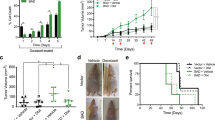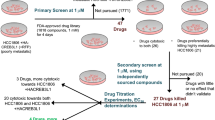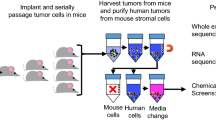Abstract
Among microtubule-targeting agents, docetaxel has received recent interest owing to its good therapeutic index. Clinical trials have underlined its potential for the treatment of advanced breast cancer, although little is known about its molecular mode of action in this context. We characterized the molecular changes induced by docetaxel in two well-known human breast carcinoma cell lines. Two mechanisms of action according to drug concentration were suggested by a biphasic sensitivity curve, and were further validated by cell morphology, cell cycle and cell death changes. Two to four nanomolar docetaxel induced aberrant mitosis followed by late necrosis, and 100 nM docetaxel induced mitotic arrest followed by apoptosis. Passing through mitosis phase was a requirement for hypodiploidy to occur, as shown by functional studies in synchronized cells and by combining docetaxel with the proteasome inhibitor MG132. Transcriptional profiling showed differences according to cell line and docetaxel concentration, with cell cycle, cell death and structural genes commonly regulated in both cell lines. Although p53 targets were mainly induced with low concentration of drug in MCF7 cells, its relevance in the dual mechanism of docetaxel cytotoxicity was ruled out by using an isogenic shp53 cell line. Many of the genes shown in this study may contribute to the dual mechanism by which docetaxel inhibits the growth of breast cancer cells at different concentrations. These findings provide a basis for rationally enhancing docetaxel therapy, considering lower concentrations, and better drug combinations.
This is a preview of subscription content, access via your institution
Access options
Subscribe to this journal
Receive 50 print issues and online access
$259.00 per year
only $5.18 per issue
Buy this article
- Purchase on Springer Link
- Instant access to full article PDF
Prices may be subject to local taxes which are calculated during checkout








Similar content being viewed by others
Accession codes
References
Aapro M . (1996). The scientific rationale for developing taxoids. Anticancer Drugs 7 (Suppl 2): 33–36.
Avramis V, Nandy P, Kwock R, Solorzano M, Mukherjee S, Danenberg P et al. (1998). Increased p21/WAF-1 and p53 protein levels following sequential three drug combination regimen of fludarabine, cytarabine and docetaxel induces apoptosis in human leukemia cells. Anticancer Res 18: 2327–2338.
Baker SD, Zhao M, Lee CKK, Verweij J, Zabelina Y, Brahmer JR et al. (2004). Comparative pharmacokinetics of weekly and every-three-weeks docetaxel. Clin Cancer Res 10: 1976–1983.
Berchem G, Bosseler M, Mine N, Avalosse B . (1999). Nanomolar range docetaxel treatment sensitizes MCF-7 cells to chemotherapy induced apoptosis, induces G2M arrest and phosphorylates bcl-2. Anticancer Res 19: 535–540.
Blagosklonny MV . (2006). Prolonged mitosis versus tetraploid checkpoint: how p53 measures the duration of mitosis. Cell Cycle 5: 971–975.
Blagosklonny MV, Robey R, Sackett DL, Du L, Traganos F, Darzynkiewicz Z et al. (2002). Histone deacetylase inhibitors all Induce p21 but differentially cause tubulin acetylation, mitotic arrest, and cytotoxicity. Mol Cancer Ther 1: 937–941.
Blagosklonny MV, Schulte T, Nguyen P, Trepel J, Neckers L . (1996). Taxol-induced apoptosis and phosphorylation of Bcl-2 protein involves c-Raf-1 and represents a novel c-Raf-1 signal transduction pathway. Cancer Res 56: 1851–1854.
Blajeski AL, Kottke TJ, Kaufmann SH . (2001). A Multistep Model for Paclitaxel-Induced Apoptosis in Human Breast Cancer Cell Lines. Exp Cell Res 270: 277–288.
Boudny V, Nakano S . (2002). Src tyrosine kinase augments taxotere-induced apoptosis through enhanced expression and phosphorylation of Bcl-2. Br J Cancer 86: 463–469.
Brown I, Shalli K, McDonald S, Moir S, Hutcheon A, Heys S et al. (2004). Reduced expression of p27 is a novel mechanism of docetaxel resistance in breast cancer cells. Breast Cancer Res 6: R601–R607.
Caraglia M, Giuberti G, Marra M, Di Gennaro E, Facchini G, Caponigro F et al. (2005). Docetaxel induces p53-dependent apoptosis and synergizes with farnesyl transferase inhibitor r115777 in human epithelial cancer cells. Front Biosci 10: 2566–2575.
Carmichael J, DeGraff W, Gazdar A, Minna J, Mitchell J . (1987). Evaluation of a tetrazolium-based semiautomated colorimetric assay: assessment of chemosensitivity testing. Cancer Res 47: 936–942.
Chang BD, Broude EV, Fang J, Kalinichenko TV, Abdryashitov R, Poole JC et al. (2000). p21Waf1/Cip1/Sdi1-induced growth arrest is associated with depletion of mitosis-control proteins and leads to abnormal mitosis and endoreduplication in recovering cells. Oncogene 19: 2165–2170.
Chen J-G, Yang C-PH, Cammer M, Band Horwitz S . (2003). Gene expression and mitotic exit induced by microtubule-stabilizing drugs. Cancer Res 63: 7891–7899.
Consolini R, Pui C, Behm F, Raimondi S, Campana D . (1998). In vitro cytotoxicity of docetaxel in childhood acute leukemias. J Clin Oncol 16: 907–913.
Dieras V, Fumoleau P, Bourgeois H, Misset JL, Azli N, Pouillart P . (1996). Taxoids in combination chemotherapy for metastatic breast cancer. Anticancer Drugs 7 (Suppl 2): 47–52.
Escuin D, Kline ER, Giannakakou P . (2005). Both microtubule-stabilizing and microtubule-destabilizing drugs inhibit hypoxia-inducible factor-1{alpha} accumulation and activity by disrupting microtubule function. Cancer Res 65: 9021–9028.
Fabbri F, Carloni S, Brigliadori G, Zoli W, Lapalombella R, Marini M . (2006). Sequential events of apoptosis involving docetaxel, a microtubule-interfering agent: A cytometric study. BMC Cell Biol 7: 6.
Fumoleau P, Chevallier B, Kerbrat P, Krakowski Y, Misset JL, Maugard-Louboutin C et al. (1996). A multicentre phase II study of the efficacy and safety of docetaxel as first-line treatment of advanced breast cancer: report of the Clinical Screening Group of the EORTC. Ann Oncol 7: 165–171.
Giannakakou P, Nakano M, Nicolaou KC, O’Brate A, Yu J, Blagosklonny MV et al. (2002). Enhanced microtubule-dependent trafficking and p53 nuclear accumulation by suppression of microtubule dynamics. Proc Natl Acad Sci USA 99: 10855–10860.
Giannakakou P, Robey R, Fojo T, Blagosklonny M . (2001). Low concentrations of paclitaxel induce cell type-dependent p53, p21 and G1/G2 arrest instead of mitotic arrest: molecular determinants of paclitaxel-induced cytotoxicity. Oncogene 20: 3806–3813.
Grandori C, Wu K-J, Fernandez P, Ngouenet C, Grim J, Clurman BE et al. (2003). Werner syndrome protein limits MYC-induced cellular senescence. Genes Dev 17: 1569–1574.
Haldar S, Basu A, Croce C . (1997). Bcl2 is the guardian of microtubule integrity. Cancer Res 57: 229–233.
Hernández-Vargas H, Ballestar E, Carmona-Saez P, von Kobbe C, Bañón-Rodríguez I, Esteller M et al. (2006). Transcriptional profiling of MCF7 breast cancer cells in response to 5-Fluorouracil: relationship with cell cycle changes and apoptosis, and identification of novel targets of p53. Int J Cancer 119: 1164–1175.
Jordan M, Wendell K, Gardiner S, Derry W, Copp H, Wilson L . (1996). Mitotic block induced in HeLa cells by low concentrations of paclitaxel (Taxol) results in abnormal mitotic exit and apoptotic cell death. Cancer Res 56: 816–825.
Li Y, Li X, Hussain M, Sarkar F . (2004). Regulation of microtubule, apoptosis, and cell cycle-related genes by taxotere in prostate cancer cells analyzed by microarray. Neoplasia 6: 158–167.
Mansilla S, Priebe W, Portugal J . (2006). Mitotic catastrophe results in cell death by caspase-dependentand caspase-independent mechanisms. Cell Cycle 5: 53–60.
Montero A, Fosella F, Hortobagyi GN, Valero V . (2005). Docetaxel for treatment of solid tumours: a systematic review of clinical data. Lancet Oncol 6: 229–239.
Moreno-Bueno G, Sanchez-Estevez C, Cassia R, Rodriguez-Perales S, Diaz-Uriarte R, Dominguez O et al. (2003). Differential gene expression profile in endometrioid and nonendometrioid endometrial carcinoma: STK15 is frequently overexpressed and amplified in nonendometrioid carcinomas. Cancer Res 63: 5697–5702.
Morse DL, Gray H, Payne CM, Gillies RJ . (2005). Docetaxel induces cell death through mitotic catastrophe in human breast cancer cells. Mol Cancer Ther 4: 1495–1504.
Nawrocki ST, Sweeney-Gotsch B, Takamori R, McConkey DJ . (2004). The proteasome inhibitor bortezomib enhances the activity of docetaxel in orthotopic human pancreatic tumor xenografts. Mol Cancer Ther 3: 59–70.
Olivier M, Eeles R, Hollstein M, Khan MA, Harris CC, Hainaut P . (2002). The IARC TP53 database: new online mutation analysis and recommendations to users. Hum Mutat 19: 607–614.
Paoletti A, Giocanti N, Favaudon V, Bornens M . (1997). Pulse treatment of interphasic HeLa cells with nanomolar doses of docetaxel affects centrosome organization and leads to catastrophic exit of mitosis. J Cell Sci 110: 2403–2415.
Roninson IB, Broude EV, Chang B-D . (2001). If not apoptosis, then what? Treatment-induced senescence and mitotic catastrophe in tumor cells. Drug Resist Update 4: 303–313.
Stankiewicz AR, Lachapelle G, Foo CPZ, Radicioni SM, Mosser DD . (2005). Hsp70 inhibits heat-induced apoptosis upstream of mitochondria by preventing Bax translocation. J Biol Chem 280: 38729–38739.
Tarsounas M, Munoz P, Claas A, Smiraldo PG, Pittman DL, Blasco MA et al. (2004). Telomere maintenance requires the RAD51D recombination/repair protein. Cell 117: 337–347.
Torres K, Horwitz S . (1998). Mechanisms of Taxol-induced cell death are concentration dependent. Cancer Res 58: 3620–3626.
Veronesi U, Boyle P, Goldhirsch A, Orecchia R, Viale G . (2005). Breast cancer. Lancet 365: 1727–1741.
von Kobbe C, May A, Grandori C, Bohr VA . (2004). Werner syndrome cells escape hydrogen peroxide-induced cell proliferation arrest. FASEB J 18: 1970–1972.
Wang Q, Wieder R . (2004). All-trans retinoic acid potentiates Taxotere-induced cell death mediated by Jun N-terminal kinase in breast cancer cells. Oncogene 23: 426–433.
Yoo GH, Piechocki MP, Ensley JF, Nguyen T, Oliver J, Meng H et al. (2002). Docetaxel induced gene expression patterns in head and neck squamous cell carcinoma using cDNA microarray and PowerBlot. Clin Cancer Res 8: 3910–3921.
Zeng S, Chen YZ, Fu L, Johnson KR, Fan W . (2000). In vitro evaluation of schedule-dependent interactions between docetaxel and doxorubicin against human breast and ovarian cancer cells. Clin Cancer Res 6: 3766–3773.
Acknowledgements
We thank Dr Cayetano von Kobbe for the generation of shp53 MCF7 cells. We are grateful to CNIO Confocal Microscopy and Cytometry Units. This work was supported by Ministerio de Educación y Ciencia, Grant Reference PTR1995-0753-OP and Ministerio de Ciencia y Tecnología SAF2001-0065 and SAF2004-08258-C02-01. GMB is junior investigator of the Ramón y Cajal Program 2004.
Author information
Authors and Affiliations
Corresponding author
Additional information
Supplementary Information accompanies the paper on the Oncogene website (http://www.nature.com/onc).
Supplementary information
Rights and permissions
About this article
Cite this article
Hernández-Vargas, H., Palacios, J. & Moreno-Bueno, G. Molecular profiling of docetaxel cytotoxicity in breast cancer cells: uncoupling of aberrant mitosis and apoptosis. Oncogene 26, 2902–2913 (2007). https://doi.org/10.1038/sj.onc.1210102
Received:
Revised:
Accepted:
Published:
Issue Date:
DOI: https://doi.org/10.1038/sj.onc.1210102
Keywords
This article is cited by
-
Utilizing two-dimensional monolayer and three-dimensional spheroids to enhance radiotherapeutic potential by combining gold nanoparticles and docetaxel
Cancer Nanotechnology (2023)
-
The CellPhe toolkit for cell phenotyping using time-lapse imaging and pattern recognition
Nature Communications (2023)
-
Benzimidazole carbamate induces cytotoxicity in breast cancer cells via two distinct cell death mechanisms
Cell Death Discovery (2023)
-
Nanoencapsulation of Docetaxel Induces Concurrent Apoptosis and Necroptosis in Human Oral Cancer Cells (SCC-9) via TNF-α/RIP1/RIP3 Pathway
Indian Journal of Clinical Biochemistry (2023)
-
Synergistic co-administration of docetaxel and curcumin to chemoresistant cancer cells using PEGylated and RIPL peptide-conjugated nanostructured lipid carriers
Cancer Nanotechnology (2022)



